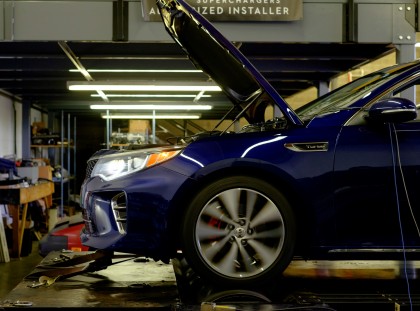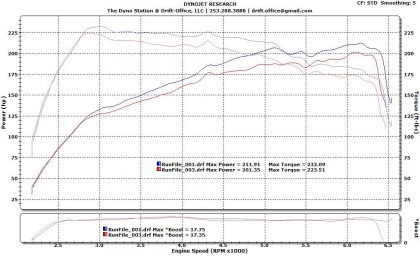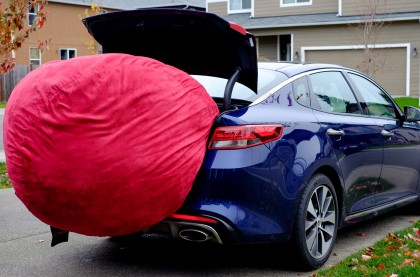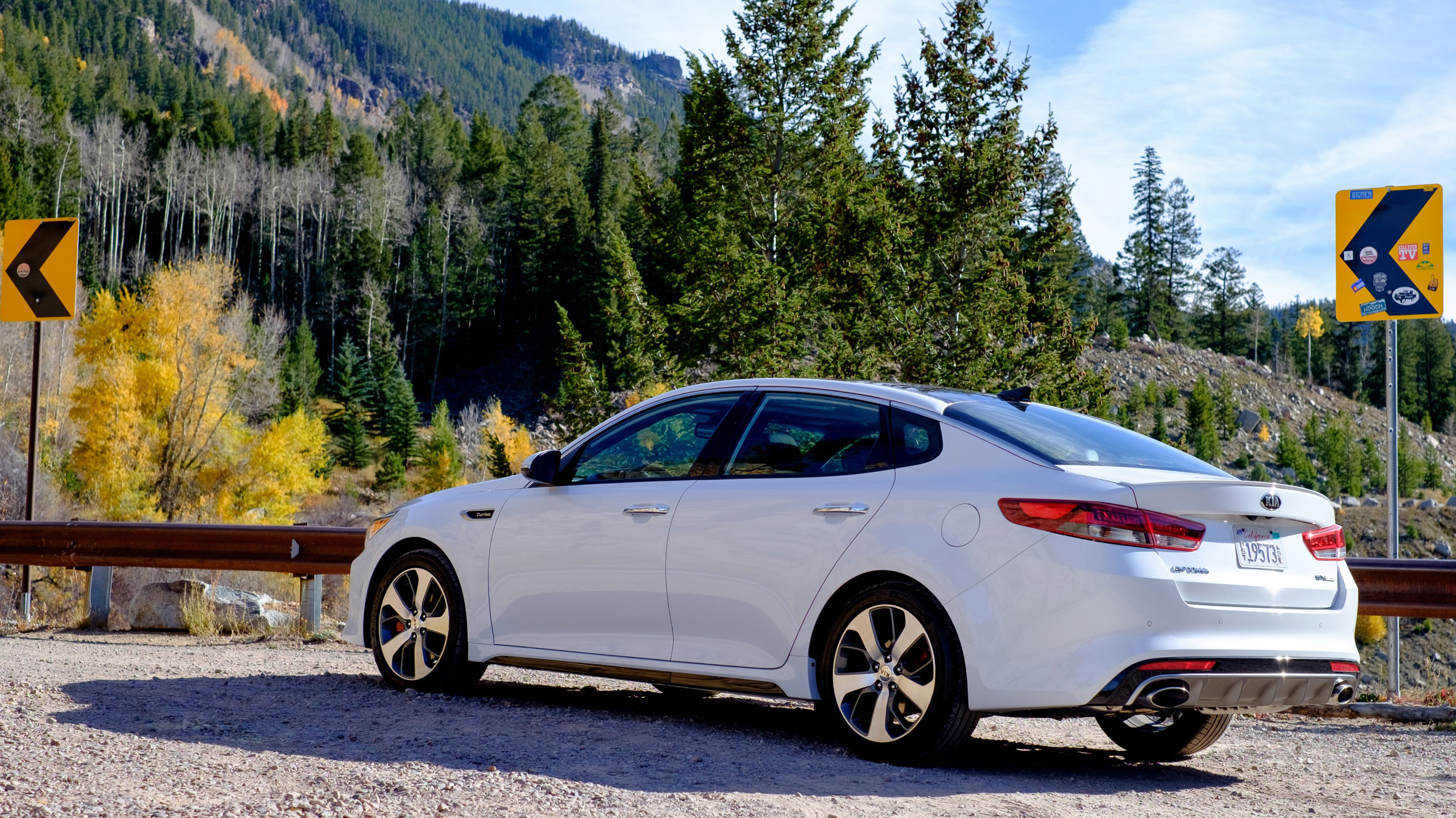Why you can trust TechRadar
Kia's Optima SX and SX Limited trims come standard with the 2.0-liter turbo, 4-cylinder motor, rack-mounted, power steering motor and sport-tuned suspension. The 2.0t is rated at 245 horsepower (hp) with 260 pound-per-foot of torque, which is down from the previous generation's 274 hp and 269 pound-per-foot.
However, numbers aren't everything, as the new Optima makes peak torque at 1,350 rotations per minute (RPM) instead of 1,650 RPM. The new Optima employs a smaller, twin-scroll turbo to achieve these power ratings. The 2.0t is mated to the same 6-speed automatic as the previous generation.
While power is down on the new Optima, Kia engineers tuned the engine for a smoother power curve that improves drivability. There's no high-RPM power surge, as with the previous generation, only linear smoothness. Despite being down on power, you can spin the tires a little when flooring it from a stop and it never felt slow. I wouldn't call it fast but there's plenty of passing power at high altitudes (I drove up to 12,000 feet above sea level) thanks to the turbo.

We partnered up with Drift-Office, a local tuning shop co-founded by a good friend of mine, to put the Optima on a vehicle dynamometer (dyno), which measures power output through the wheels by having the vehicle to spin rollers that measure the amount of force applied, and verify Kia's number ratings and check out the power curve. When I tested the vehicle, it was a typical Washington day with an average temperature of 48 degrees Fahrenheit with around 74% humidity at around 69 feet above sea level. The car was strapped down and ran three times.

The Optima made 211hp at the wheels on the first run, which shows about 12% of power loss through the drivetrain. Power loss can be upwards to 20% depending on the car, drive wheels and transmission but it produces respectable numbers.
The power curve is very linear without random power surges, and backs up Kia's claim of tuning the engine for smoothness. The later runs generated less power due to heat soak, which happens when a car is on a dyno with a large fan blowing air at it – this isn't something that typically happens in regular driving, unless it's extremely hot outside.
The US Environmental Protection Agency rates the Optima with the 2.0-liter turbo at 22 in the city, 32 on the highway and 25 combined miles-per-gallon. My lead-footed driving saw fuel economy around 20 MPG in primarily city driving. I'm sure your average driver should see the rated numbers, but it's hard not to mash the gas pedal and listen to the tires squeal.
Sign up for breaking news, reviews, opinion, top tech deals, and more.
Kia offers a 1.6-liter turbo and 2.4-liter 4-cylinder motors that are more economical as well. The 1.6-liter turbo is an economical gem that's rated for 28 in the city, 39 on the highway and 32 combined MPG, while the base 2.4-liter only gains 2-3 MPG more across the board than the turbo 2.0-liter. However, the 1.6 turbo and 2.4-liter motors have column-mounted power steering motors and different suspension tuning, so the driving dynamics are completely different. My take on the Optima's driving performance strictly refers to the SX and SX Limited.
Steering feel on the Optima gives you a feel of the surface, tight response and the right amount of weight to inspire confidence. Kia has come a long way in terms of driving dynamics, and the Optima is a solid driving mid-size sedan. There's a driver mode select button that alters steering, throttle response and transmission shifting depending on which mode you select – normal, sport or eco. I left the car in sport mode most of the time as I prefer a heavier and tighter steering feel and quicker transmission shifts.
Paddle shifters are available behind the steering wheel and mounted to the wheel, which is what I prefer instead of column-mounted paddles. The downside is that there's a noticeable delay when pressing the paddles to when the transmission shifts.

If the Optima were a sports car, this would be a major drawback, but it's less of a problem as a family sedan. It does stay in the selected gear to the engine redline (the highest RPM the engine can go) when in manual mode, so you can downshift and drive aggressively through windy roads without fear of automatic upshifts mid-corner.
The power steering applies the right amount of weight at the right speeds for a pleasant drive through winding roads. Suspension tuning strikes the balance of sporty handling and comfort without noticeable body roll while spiritedly driving through the mountain roads without breaking the law (too much). The 2016 Optima isn't on the same level as the Mazda 6 when it comes to driving dynamics, but it's very close and offers an excellent driving experience.
Living with it
Everything about the Kia Optima looks good, but what is it like to live with (you know, with kids)? We partnered up with Diono, a car seat manufacturer, to test fit three car seats in the back of the car. Diono's USA headquarters is in Puyallup, Wash., where I conduct vehicle testing and a convenient place to stop by and test-fit car seats. With the help of Diono, I installed three Radian RXT convertible car seats in the back of the Optima.
The Optima has two pairs of lower LATCH anchors in the outboard seats, and the middle seat requires using the regular seat belt. Top LATCH anchors are present for all three seats. The seats were installed with the vehicle seat belts and not LATCH anchors.

All three seats fit fine in the Optima. I tried the middle car seat in front and rear-facing positions without space issues. The only caveat is the buckle for the middle seat sits a little high, so my Diono representative had to twist it two turns so that it sits lower. I was reassured this does not affect the safety of the car seat or installation.
When rear-facing, the Radian RXT can protrude into the front of the car due to how tall it is. This is easily resolved using Diono's angle-adjuster accessory, which I tested with it as well. Ultimately, the 2016 Optima can safely fit three Diono Radian RXT car seats in the back. I am not able to test other car seats and can't confirm if other brand models will fit in a three-across configuration.
Junk in the trunk
Walk up to the trunk of the Optima with the key fob in your pocket and the car automatically opens the trunk for you. Kia calls this feature "Smart Trunk," and it makes your life easier if your hands are full, theoretically.
The Smart Trunk only activates if the car is locked and you walk behind the car. It sounds off a couple beeps as an audible warning before the trunk is opened. If it's beeping and you didn't want to open the trunk, simply walk away and it'll cancel.
In the perfect scenario, you'll have your hands full with the kids and groceries, walk up to the car and the trunk magically opens for you. In reality, Kia's Smart Trunk pops open the trunk but it doesn't have a powered trunk to automatically raise it for you, so you still have to open the trunk albeit with one less step.

Kia claims the Optima has 15.9 cubic feet of trunk space, and it does have a very large trunk. To test how usable the trunk is, I keep Sumo Gigantor and Omni bean bags from Sumo Lounge around for trunk fitting tests. The Sumo sacks can easily contour to odd trunk space layouts, too. It's a fun way I devised to visualize how big a trunk is that can produce interesting images.
I dragged the Sumo Omni outside to put in the trunk of the Optima without much luck – and odd stares from neighbors. The 60 x 60 x 38-inch bean bag didn't fit due to the small opening.
While your typical boxes and suitcases should fit in the Optima without issues, it's the odd-sized item that is a problem. If you need to haul large items a lot, a sedan isn't ideal and you're better off with a wagon (estate for our UK readers), minivan or crossover.
Current page: Performance and living with it
Prev Page Audio, driver assists and more Next Page Verdict